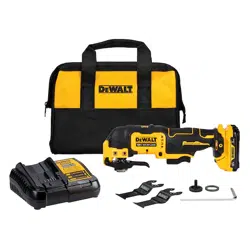Loading ...
Loading ...
Loading ...

ENGLISH
8
Additional Safety Information
WARNING: Never modify the power tool or any part of
it. Damage or personal injury couldresult.
WARNING: ALWAYS use safety glasses. Everyday
eyeglasses are NOT safety glasses. Also use face or
dust mask if cutting operation is dusty. ALWAYS WEAR
CERTIFIED SAFETYEQUIPMENT:
• ANSI Z87.1 eye protection (CAN/CSA Z94.3),
• ANSI S12.6 (S3.19) hearing protection,
• NIOSH/OSHA/MSHA respiratoryprotection.
WARNING:
Some dust created by power sanding,
sawing, grinding, drilling, and other construction
activities contains chemicals known to the State
of California to cause cancer, birth defects or
other reproductive harm. Some examples of these
chemicalsare:
• lead from lead‑based paints,
• crystalline silica from bricks and cement and other
masonry products, and
• arsenic and chromium from
chemically‑treatedlumber.
Your risk from these exposures varies, depending on
how often you do this type of work. To reduce your
exposure to these chemicals: work in a well ventilated
area, and work with approved safety equipment, such
as those dust masks that are specially designed to filter
out microscopicparticles.
masks do not offer this protection. See your local hardware
dealer for the proper (NIOSH approved)mask.
• NO EATING, DRINKING or SMOKING should be done in
the work area to prevent ingesting contaminated paint
particles. Workers should wash and clean up BEFORE
eating, drinking or smoking. Articles of food, drink, or
smoking should not be left in the work area where dust
would settle onthem.
Environmental Safety
• Paint should be removed in such a manner as to
minimize the amount of dustgenerated.
• Areas where paint removal is occurring should be sealed
with plastic sheeting of 4milsthickness.
• Sanding should be done in a manner to reduce tracking
of paint dust outside the workarea.
Cleaning and Disposal
• All surfaces in the work area should be vacuumed
and thoroughly cleaned daily for the duration of
the sanding project. Vacuum filter bags should be
changedfrequently.
• Plastic drop cloths should be gathered up and disposed
of along with any dust chips or other removal debris
They should be placed in sealed refuse receptacles and
disposed of through regular trash pick-up procedures
During clean up, children and pregnant women should
be kept away from the immediate workarea.
• All toys, washable furniture and utensils used by children
should be washed thoroughly before being usedagain.
Specific Safety Warnings and
Instructions: Sanders
Sanding Lead Based Paint
Sanding of lead based paint is NOT RECOMMENDED due
to the difficulty of controlling the contaminated dust.
The greatest danger of lead poisoning is to children and
pregnantwomen.
Since it is difficult to identify whether or not a paint contains
lead without a chemical analysis, we recommend the
following precautions when sanding any paint:
Personal Safety
• No children or pregnant women should enter the work
area where the paint sanding is being done until all clean
up iscompleted.
• A dust mask or respirator should be worn by all persons
entering the work area. The filter should be replaced daily
or whenever the wearer has difficultybreathing.
NOTE: Only those dust masks suitable for working with lead
paint dust and fumes should be used. Ordinary painting
• Do not operate this tool for long periods of time.
Vibration caused by the operating action of this tool may
cause permanent injury to fingers, hands, and arms. Use
gloves to provide extra cushion, take frequent rest periods,
and limit daily time ofuse.
• Do not restart the cutting operation in the work
piece. Let the tool reach full speed and carefully re‑enter
thecut.
• Do not “jam” the saw blade or apply excessive
pressure. Do not attempt to make an excessive depth
ofcut.
• Keep your hands away from cutting area. Do not reach
under the material beingcut.
• Do not use dull or damaged blades. Bent blade can
break easily or cause kickback. Exercise extreme caution
when handling the accessories. The accessories are very
sharp. Wear protective gloves when changing cutting
accessories. Accessories become hot after prolongedusage.
• Before scraping, check work piece for nails. If there are
nails, either remove them or set them well below intended
finished surface. Striking a nail with accessory edge could
cause the tool tojump.
• Do not wet sand with this tool. Liquids entering the
motor housing are an electrical shockhazard.
• Never work in area which is soaked with a liquid, such
as a solvent or water, or dampened such as newly
applied wallpaper. There is an electrical shock hazard
when working in such conditions with a power tool and
heating of the liquid caused by scraping action may cause
harmful vapors to be emitted from workpiece.
• Do not use sandpaper intended for larger sanding
pads. Larger sandpaper will extend beyond the sanding
pad causing snagging, tearing of the paper or kick‑back.
Extra paper extending beyond the sanding pad can also
cause seriouslacerations.
Loading ...
Loading ...
Loading ...
